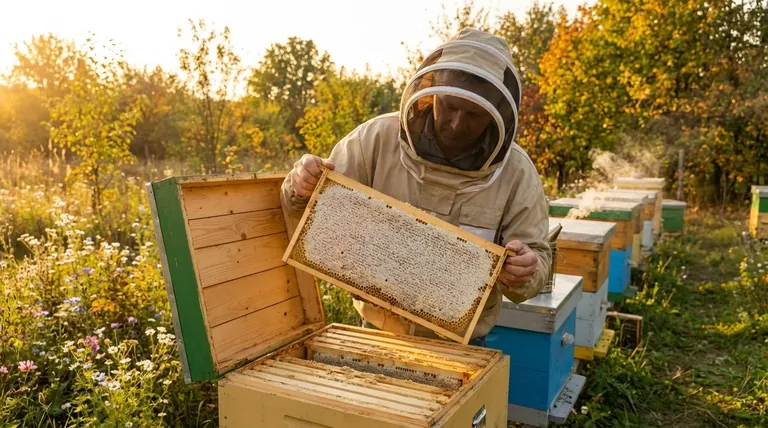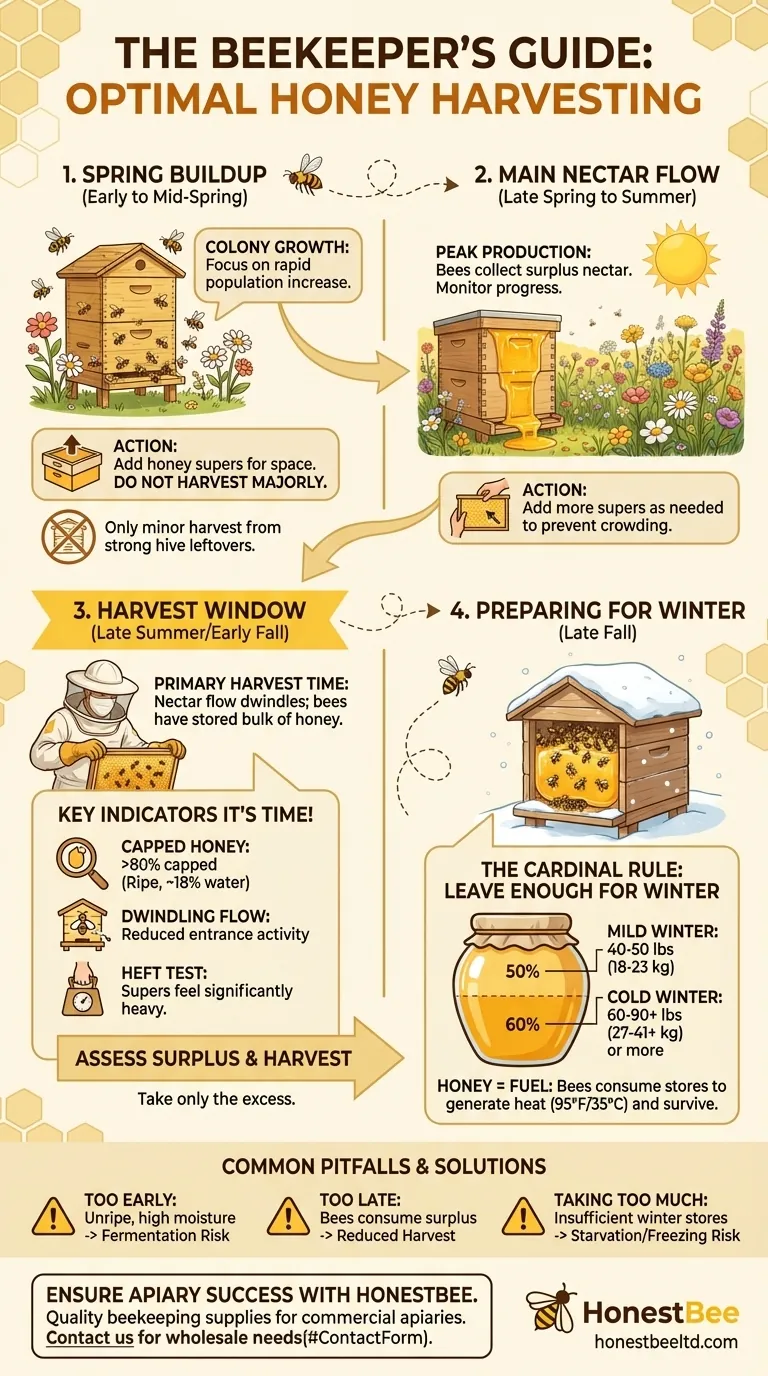Ultimately, the best time to harvest surplus honey is at the end of the main nectar flow in your specific region, which typically occurs in late summer or early fall. The primary goal is to take only the honey the bees will not need to survive the upcoming winter, ensuring the colony's health remains the top priority.
The core principle of honey harvesting is not tied to a specific calendar date, but to the natural cycle of the hive and its environment. You harvest when the bees have produced a surplus beyond their own needs and have finished capping the honey, signaling it is ripe and ready.

The Beekeeper's Calendar: Aligning with the Nectar Flow
Timing your harvest correctly requires understanding the annual cycle of a honeybee colony. The process is less about dates and more about observing the bees and the available forage.
The Spring Buildup
In the spring, the queen's egg-laying accelerates dramatically. The colony's focus is on rapid population growth to build a powerful foraging workforce.
While a minor harvest is sometimes possible if a very strong colony has a large surplus of leftover winter stores, spring is generally not the time for a major harvest. Instead, this is when you add your honey supers (extra boxes for honey storage), often by mid-to-late spring, to give a strong colony room to store incoming nectar.
The Main Nectar Flow
This is the period of peak nectar availability, usually spanning from late spring through summer. The foragers work tirelessly, and if conditions are right, they will collect far more nectar than the colony needs for its immediate use.
This is the time when bees fill the honey supers you provided. Your job during this phase is to monitor their progress and add more supers if they are running out of space.
The Late Summer/Early Fall Harvest Window
This is the primary and most significant harvest window for most beekeepers. It occurs when the main nectar flow begins to dwindle.
At this point, the bees have stored the bulk of the season's honey. Harvesting now allows you to accurately assess the total yield and, most importantly, determine how much honey the colony truly needs to be left with for winter.
The Cardinal Rule: How Much Honey to Leave for Winter
Taking too much honey is one of the most serious mistakes a beekeeper can make. A colony's winter survival depends entirely on having adequate food stores to generate heat and sustain itself until spring.
Why Bees Need Their Honey
Honey is the carbohydrate fuel that bees metabolize to vibrate their wing muscles, generating heat. A cluster of bees maintains a core temperature of around 95°F (35°C) all winter, even in freezing conditions, which requires an immense amount of energy.
A Regional Calculation
The amount of honey a colony needs is not universal; it depends entirely on the length and severity of your local winter.
In regions with mild winters, 40-50 pounds (18-23 kg) might be sufficient. For areas with long, cold winters, the requirement is much higher, often between 60 and 90 pounds (27-41 kg) or more. A deep hive body full of honey weighs approximately 80-90 pounds.
Key Indicators It's Time to Harvest
Look for these definitive signs that the honey is ready and the timing is right.
- Capped Honey: Bees seal a cell of honey with a wax capping only when the water content has been reduced to ~18%. Honey that is at least 80% capped is considered "ripe" and will not ferment in storage. This is the single most important indicator.
- A Dwindling Nectar Flow: You will notice a visible reduction in hive entrance activity. The "nectar dearth" means bees will begin to consume their stores, so it's time to harvest the surplus before they do.
- The "Heft Test": A honey super that is ready for harvest will feel significantly heavy when you try to lift it. A full deep super can weigh over 80 pounds.
Understanding the Trade-offs and Common Pitfalls
Every decision involves balancing rewards with risks. A thoughtful beekeeper understands these potential missteps.
Pitfall: Harvesting Too Early
If you harvest honey before it is at least 80% capped, its moisture content will be too high. This "unripe" honey is prone to fermentation, ruining your entire harvest.
Pitfall: Harvesting Too Late
If you wait too long after the nectar flow has stopped, the bees will begin consuming the honey stored in the supers. You will be harvesting less than you could have, and you risk confusing your winter-store calculations.
Pitfall: Taking Too Much
This is the most critical error. Leaving a colony with insufficient stores forces you to intervene with supplemental feeding and puts the bees at high risk of starvation and freezing over winter. Always err on the side of leaving too much honey.
Making the Right Choice for Your Hive
Your harvesting strategy should be tailored to your climate and goals, with colony health as the guiding principle.
- If your primary focus is maximizing a single harvest: Target the moment the main nectar flow ends in late summer, ensuring at least 80% of the honey is capped.
- If your primary focus is colony health in a cold climate: Be conservative. Leave more honey than you think they'll need, especially for a young or developing colony. A full deep box is a good benchmark.
- If your primary focus is a small, opportunistic harvest: Inspect a powerful hive in early spring. If it's packed with bees and has an entire super of leftover honey from winter, you can take some after the new spring nectar flow has clearly begun.
Always remember that you are a steward of your bees' well-being first and a honey harvester second.
Summary Table:
| Harvest Timing Factor | Key Indicator | Action Required |
|---|---|---|
| Nectar Flow | Main flow has ended (late summer/early fall) | Assess surplus honey in supers. |
| Honey Ripeness | At least 80% of honey cells are capped by bees. | Harvest to prevent fermentation. |
| Colony Needs | Calculate winter honey needs based on local climate (e.g., 60-90 lbs for cold winters). | Leave adequate stores; harvest only the surplus. |
| Hive Inspection | Honey supers are heavy (heft test) and bees are less active. | Plan harvest to avoid bees consuming their surplus. |
Ensure your apiary's success with the right equipment and supplies. Harvesting honey at the optimal time is crucial for both yield and colony health. HONESTBEE supplies commercial apiaries and beekeeping equipment distributors with durable, wholesale-focused beekeeping supplies—from honey supers and extractors to protective gear—to support your operations through every season. Contact our expert team today to discuss your wholesale needs and how we can help your business thrive.
Visual Guide

Related Products
- 10L Stainless Steel Electric Honey Press Machine
- Electric Flatting and Embossing Machine with Tray for Beekeeping
- Stainless Steel Honey Press Wax Press with Tank
- Stainless Steel Manual Honey Press with Guard for Pressing Honey and Wax
- Professional Wide Blade Honey Scraper for Beekeeping and Honey Processing
People Also Ask
- What are the key features of the stainless steel honey press? Maximize Yield & Guarantee Purity
- What voltage options are available for stainless steel screw honey pumps? Choose the Right Power for Your Scale
- What are the key features of a honey press? Maximize Yield with Durable, Efficient Extraction
- How does pressed honey compare to extracted or crush-and-strain? Unlock the Full Flavor of the Hive
- How does the press method for extracting honey work? A Simple, Low-Cost Guide for Beekeepers



















